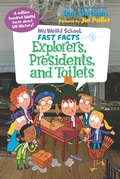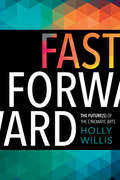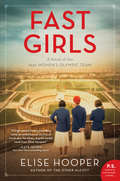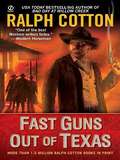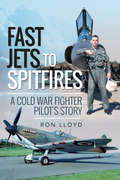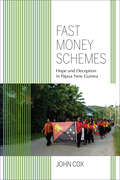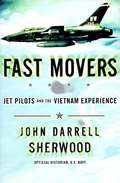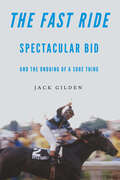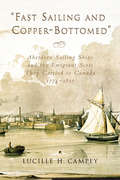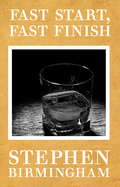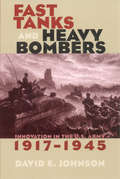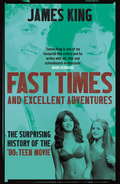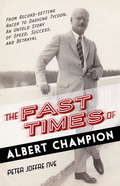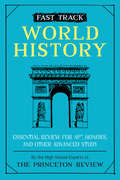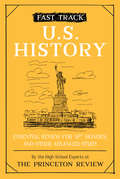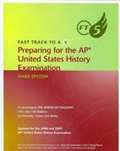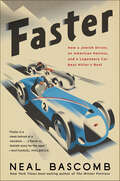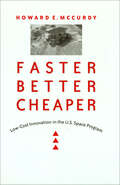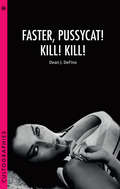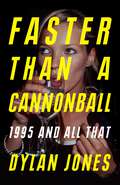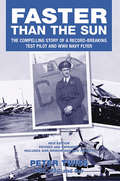- Table View
- List View
Fast Facts: Explorers, Presidents, and Toilets (My Weird School )
by Dan Gutman Jim PaillotThink fast with A.J. and Andrea from My Weird School!Did you know that the word “independence” never appears in the Declaration of Independence? Did you know that soldiers in World War I collected thousands of glowworms in jars to help them see at night?!<P><P>Learn more weird-but-true U.S. history facts with A.J. and Andrea from Dan Gutman’s bestselling My Weird School series. This all-new series of nonfiction books features hundreds of hysterical facts, plus lots of photos and illustrations. <P>Whether you're a kid who wants to learn more about our country's history or simply someone who wants to know how many Americans are involved in toilet-related injuries each year, this is the book for you! <P>With more than 11 million books sold, the My Weird School series really gets kids reading!
Fast Forward: The Future(s) of the Cinematic Arts
by Holly WillisCinema, the primary vehicle for storytelling in the twentieth century, is being reconfigured y new media in the twenty-first. Terms such as "worldbuilding," "virtual reality," and "transmedia" introduce new methods for constructing a screenplay and experiencing and sharing a story. Similarly, 3D cinematography, hypercinema, and visual effects require different modes for composing an image, and virtual technology, motion capture, and previsualization completely rearrange the traditional flow of cinematic production. What does this mean for telling stories? Fast Forward answers this question by investigating a full range of contemporary creative practices dedicated to the future of mediated storytelling and by connecting with a new generation of filmmakers, screenwriters, technologists, media artists, and designers to discover how they work now, and toward what end. From Chris Milk and Aaron Koblin's exploration of VR spherical filmmaking to Rebeca Méndez's projection and installation work exploring climate change to the richly mediated interactive live performances of the collective Cloud Eye Control, this volume captures a moment of creative evolution and sets the stage for imagining the future of the cinematic arts.
Fast Forward: The Future(s) of the Cinematic Arts
by Holly WillisCinema, the primary vehicle for storytelling in the twentieth century, is being reconfigured by new media in the twenty-first. Terms such as "worldbuilding," "virtual reality," and "transmedia" introduce new methods for constructing a screenplay and experiencing and sharing a story. Similarly, 3D cinematography, hypercinema, and visual effects require different modes for composing an image, and virtual technology, motion capture, and previsualization completely rearrange the traditional flow of cinematic production. What does this mean for telling stories? Fast Forward answers this question by investigating a full range of contemporary creative practices dedicated to the future of mediated storytelling and by connecting with a new generation of filmmakers, screenwriters, technologists, media artists, and designers to discover how they work now, and toward what end. From Chris Milk and Aaron Koblin's exploration of VR spherical filmmaking to Rebeca Méndez's projection and installation work exploring climate change to the richly mediated interactive live performances of the collective Cloud Eye Control, this volume captures a moment of creative evolution and sets the stage for imagining the future of the cinematic arts.
Fast Girls: A Novel of the 1936 Women's Olympic Team
by Elise Hooper“Fast Girls is a compelling, thrilling look at what it takes to be a female Olympian in pre-war America...Brava to Elise Hooper for bringing these inspiring heroines to the wide audience they so richly deserve.”—Tara Conklin, New York Times bestselling author of The Last Romantics and The House Girl Acclaimed author Elise Hooper explores the gripping, real life history of female athletes, members of the first integrated women’s Olympic team, and their journeys to the 1936 summer games in Berlin, Nazi Germany. Perfect for readers who love untold stories of amazing women, such as The Only Woman in the Room, Hidden Figures, and The Lost Girls of Paris. In the 1928 Olympics, Chicago’s Betty Robinson competes as a member of the first-ever women’s delegation in track and field. Destined for further glory, she returns home feted as America’s Golden Girl until a nearly-fatal airplane crash threatens to end everything. Outside of Boston, Louise Stokes, one of the few black girls in her town, sees competing as an opportunity to overcome the limitations placed on her. Eager to prove that she has what it takes to be a champion, she risks everything to join the Olympic team. From Missouri, Helen Stephens, awkward, tomboyish, and poor, is considered an outcast by her schoolmates, but she dreams of escaping the hardships of her farm life through athletic success. Her aspirations appear impossible until a chance encounter changes her life. These three athletes will join with others to defy society’s expectations of what women can achieve. As tensions bring the United States and Europe closer and closer to the brink of war, Betty, Louise, and Helen must fight for the chance to compete as the fastest women in the world amidst the pomp and pageantry of the Nazi-sponsored 1936 Olympics in Berlin.
Fast Guns Out Of Texas
by Ralph CottonCray Dawson is en route to Black's Cut in Montana to stake his claim when he learns his old friend Fast Larry Shaw faked his death to escape his notoriety as a gunfighter. But Dawson discovers that his own prowess with firearms haunts him too.
Fast Jets to Spitfires: A Cold War Fighter Pilot's Story
by Ron LloydA memoir of RAF service in the postwar era and the golden age of British military aviation, including photos.How often have you glanced skyward at the sound of a passing aircraft and wondered what it would be like to fly one of those gleaming metal machines? Or admired the skill and daring of the fighter pilot swooping down upon his enemy in the awe-inspiring, unrivaled elegance of a Spitfire? Ron Lloyd has had the experience of flying the majestic propeller-driven aircraft of the Second World War as well as the roaring, sound-barrier-breaking jets of the Cold War—and in this exciting book, he places the reader in the cockpit, describing what it really feels like to be sitting at the controls of a fighter aircraft.Lloyd joined the RAF after World War II, and during his early service he was selected as one of the pilots to fly the wartime aircraft in the feature film The Battle of Britain, giving him the opportunity to fly a Spitfire and even a Messerschmitt Bf 109 during the six weeks of filming. His role with the RAF, on the other hand, saw him on the front line in the Cold War, piloting de Havilland Vampires, Hawker Hunters, Gloster Javelins, Lightnings, and Phantoms. He also served on exchange in the USA where he flew Convair F-102s, Convair F-106s, and Lockheed T-33s.Packed with unique photographs of the golden age of British military aviation, Fast Jets to Spitfires allows readers to experience, through Ron Lloyd’s graphic accounts, the pure joy of being airborne.
Fast Money Schemes: Hope and Deception in Papua New Guinea (Framing the Global)
by John CoxA history and anthropological analysis of one of Papua New Guinea’s worst Ponzi schemes in the late 1990s.In the late 1990s and early 2000s a wave of Ponzi schemes swept through Papua New Guinea, Australia, and the Solomon Islands. The most notorious scheme, U-Vistract, attracted many thousands of investors, enticing them with promises of one percent interest to be paid monthly. Its founder, Noah Musingku, was a charismatic leader who promoted the scheme as a form of Christian mission and as the basis for establishing an independent kingdom.Fast Money Schemes uses in-depth interviews with investors, newspaper accounts, and participant observation to understand the scheme’s appeal from the point of view of those who invested and lost, showing that organizers and investors alike understood the scheme as a way of accessing and participating in a global economy. John Cox delivers a “post-village” ethnography that gives insight into the lives of urban, middle-class Papua New Guineans, a group that is not familiar to US readers and that has seldom been a focus of anthropological interest. The book’s concern with understanding the interweaving of morality, finance, and aspirations shared by a global cosmopolitan middle class has wide resonance beyond studies of Papua New Guinea and anthropology.
Fast Movers
by John SherwoodThe war in the skies above Vietnam still stands as the longest our nation has ever fought. For fourteen years American pilots dropped bombs on the Southeast Asian countryside -- eventually more than eight million tons of them. In doing so, they lost over 8,588 fixed-wing aircraft and helicopters. They did not win the war. Ironically, Vietnam, though one of our least popular wars, produced one of the most effective groups of warriors our nation has ever seen -- men of dedication, professionalism, and courage. In Fast Movers, official navy historian John Sherwood offers an authoritative social history of the air war, focused around fourteen of these aviators -- from legends like Robin Olds, Steve Ritchie, and John Nichols to lesser-known but equally heroic fighters like Roger Lerseth and Ted Sienecki. Sherwood draws on nearly 300 interviews to tell stories of great pilots and great planes in the words of the men themselves. Fliers recall jets such as McDonnell Douglas's famous F-4 Phantom, "a Corvette with wings"; the F-05 Thunderchief, the workhorse of the war; the F-8 Crusader, the last of the gun fighters; and the block-nosed but revolutionary A-6 Intruder with its fully computerized attack systems, terrain mapping radar, and digital all-weather navigation system. Ultimately, though, it was the men who mattered. Sherwood shows us the brash confidence of famous iconoclast Robin Olds, who does not hide his thrill of the hunt -- and the kill. Roger Sheets looked like Don Knotts but prepped his "Vulture Flight" of Marine A-6s with the simple, unequivocal line, "Gentlemen, let's go out and kill something." But Sherwood lets us know that it wasn't all glory, that pilots suffered fear just like other soldiers. Ed Rasimus later admitted he thought that an assignment to Thailand was "like getting diagnosed with terminal cancer: everyone is hoping the cure will come before you die." There were things worse than death, too. Fast Movers offers fascinating portraits -- based on Sherwood's interviews and just-declassified naval archives -- of Vietnam's POWs. Pilots lucky enough to suffer only broken bones and burns from the violence of 1960s-era Martin-Baker ejection seats struggled to find honorable ways to negotiate half-decade-long periods in captivity. Passive resistance, like Commander Jeremiah Denton's famous blinking of TORTURE in Morse Code, was sometimes successful, often brutally reprised. Escape was impossible. Those who avoided shootdown learned to live with other frustrations. Most wanted to "go downtown" (bomb Hanoi) but were foiled by their civilian superiors, who dictated the numbers and types of aircraft that could be used in a given strike, the kinds of ordnance that could be levied against a target, and even the flight paths that could be flown. Against all odds, the pilots spawned a culture of success in the midst of failure and frustration. Fast Movers captures a hidden and crucial story of America's least successful war.
The Fast Ride: Spectacular Bid and the Undoing of a Sure Thing
by Jack GildenIn an era of spectacular thoroughbreds, Spectacular Bid was perhaps the most exalted racehorse of them all. In 1979 he won the Kentucky Derby and the Preakness Stakes—and transcended his sport on a run of twelve consecutive stakes victories—but his quest for the Triple Crown was lost with a third-place finish in the Belmont Stakes due to a series of bizarre events that have never been accurately reported. In The Fast Ride, Jack Gilden tells the story of what really happened that day the Bid lost the biggest race of his life. Along the way, he introduces the reader to a cast of characters from the gilded age of late twentieth-century horse racing, from Bid&’s owners, the renowned Meyerhoff family, to Grover &“Buddy&” Delp, the fast-talking trainer, to teenage jockey Ronnie Franklin, whose meteoric rise to fame aboard Spectacular Bid came at the cost of his innocence and well-being. Also present are four of the era&’s magnificent Latino riders, Ángel Cordero Jr., Jacinto Vasquez, Georgie Velasquez, and Ruben Hernandez, who all felt the sting of rejection and bigotry during their long careers even as they found their way and raised the level of competition to a feverish pitch. Underlying Spectacular Bid&’s saga was a thin line between hard work and excess, including substance abuse, animal manipulation and doping, and race fixing. Hardly anyone in the horse&’s circle made it out unscathed or undamaged.The Fast Ride is the story of a great racehorse, unfulfilled dreams, the exhilaration and steep price of striving at all costs, and an American era in which getting everything you ever wanted could be the most empty and unfulfilling sensation of all.
Fast Sailing and Copper-Bottomed: Aberdeen Sailing Ships and the Emigrant Scots They Carried to Canada, 1774-1855
by Lucille H. CampeyThe days when Aberdeen’s "fast sailing and copper-bottomed" ships carried emigrant Scots to Canada are brought to life in this fascinating account of the northern Scotland exodus during the sailing ship era. Taking readers through new and little-used documentary sources, Lucille H. Campey finds convincing evidence of good ships, sailed by experienced captains and managed by reputable people, thus challenging head on the perceived imagery of abominable sea passages in leaking old tubs. And by considering the significance of ship design and size, she opens a new window on our understanding of emigrant travel. Instead of concentrating on the extreme cases of suffering and mishaps, to be found in anecdotal material, Campey’s approach is to identify all of the emigrant sea crossings to Canada made on Aberdeen sailing ships.Observing the ships which collected passengers from the port of Aberdeen as well as those which collected emigrants at Highland ports, especially Cromarty and Thurso, Campey reveals the processes at work and the people who worked behind the scenes to provide the services. Her following of the emigrant Scots on to their New World destinations in New Brunswick, Nova Scotia and Upper Canada provides us with an opportunity to see how events in Canada were influencing both the decision to emigrate and choice of location. These emigrant Scots succeeded, often after difficult beginnings, and would endow Canada with their rich traditions and culture which live on to this day.
Fast Start, Fast Finish
by Stephen BirminghamFast Start, Fast Finish is a novel of suspense, art, marriage, family, and the hollowness of suburbia, from one the country's most important documentarians of the well-to-do. Charlie Lord is handsome, smart and devastatingly sophisticated. Why does his life keep coming to a blazing halt?
Fast Tanks and Heavy Bombers: Innovation in the U.S. Army, 1917–1945 (Cornell Studies in Security Affairs)
by David E. JohnsonThe U. S. Army entered World War II unprepared. In addition, lacking Germany's blitzkrieg approach of coordinated armor and air power, the army was organized to fight two wars: one on the ground and one in the air. Previous commentators have blamed Congressional funding and public apathy for the army's unprepared state. David E. Johnson believes instead that the principal causes were internal: army culture and bureaucracy, and their combined impact on the development of weapons and doctrine. Johnson examines the U. S. Army's innovations for both armor and aviation between the world wars, arguing that the tank became a captive of the conservative infantry and cavalry branches, while the airplane's development was channeled by air power insurgents bent on creating an independent air force. He maintains that as a consequence, the tank's potential was hindered by the traditional arms, while air power advocates focused mainly on proving the decisiveness of strategic bombing, neglecting the mission of tactical support for ground troops. Minimal interaction between ground and air officers resulted in insufficient cooperation between armored forces and air forces. Fast Tanks and Heavy Bombers makes a major contribution to a new understanding of both the creation of the modern U. S. Army and the Army's performance in World War II. The book also provides important insights for future military innovation.
Fast Times and Excellent Adventures: The Surprising History of the '80s Teen Movie
by James King'Brilliant' Mail on SundayTake a trip back to the era of troubled teens and awesome soundtracks; of Reagan, rap and Ridgemont High; of MTV, VHS and 'Axel F'; of outsiders, lost boys and dead poets; of Bill and Ted, Brooke Shields and the Brat Pack; of three Porky's, two Coreys and one summer when everyone called her Baby . . . Fast Times and Excellent Adventures goes behind the scenes of a genre where cult hits mingled with studio blockbusters, where giants like Spielberg and Coppola rubbed shoulders with baby-faced first-timers and where ambitious future superstars Sean, Demi and Tom all got their big break. Music, comedy and politics - all play a part in the surprisingly complex history of the '80s teen movie. And while the films might have been aimed primarily at adolescents, the best tackle universal issues and remain a magnet to all ages. Time of your life, huh kid?From a late '70s Hollywood in flux to an early '90s indie scene that gave youth cinema a timely reboot, respected film expert James King smartly highlights the personal struggles, the social changes and the boardroom shake-ups that produced an iconic time in movie history.
Fast Times and Excellent Adventures: The Surprising History of the '80s Teen Movie
by James King'Brilliant' Mail on SundayTake a trip back to the era of troubled teens and awesome soundtracks; of Reagan, rap and Ridgemont High; of MTV, VHS and 'Axel F'; of outsiders, lost boys and dead poets; of Bill and Ted, Brooke Shields and the Brat Pack; of three Porky's, two Coreys and one summer when everyone called her Baby . . . Fast Times and Excellent Adventures goes behind the scenes of a genre where cult hits mingled with studio blockbusters, where giants like Spielberg and Coppola rubbed shoulders with baby-faced first-timers and where ambitious future superstars Sean, Demi and Tom all got their big break. Music, comedy and politics - all play a part in the surprisingly complex history of the '80s teen movie. And while the films might have been aimed primarily at adolescents, the best tackle universal issues and remain a magnet to all ages. Time of your life, huh kid?From a late '70s Hollywood in flux to an early '90s indie scene that gave youth cinema a timely reboot, respected film expert James King smartly highlights the personal struggles, the social changes and the boardroom shake-ups that produced an iconic time in movie history.
The Fast Times of Albert Champion
by Peter Joffre NyeRACER. INNOVATOR. CELEBRITY. MOGUL. CHAMPION.This is the first biography of the short but exciting life of Albert Champion--record-setting bicyclist and motorcyclist, daredevil racecar driver, early automobile innovator, charismatic ladies' man, and celebrity of the Jazz Age. Though most Americans have heard of the companies Albert Champion founded--ACDelco and Champion Spark Plug--few know much about the charismatic man behind them. Like a Richard Branson of the early 20th century, or an Evel Knievel with a business degree, Champion was a powerhouse whose life was defined by both speed and success. Champion rose from poverty in Paris to great wealth and fame in both his native France and the United States. As a bicycle racer, Champion set more than a hundred world records. When the urban speed limit was 8 mph, he was the first ever to drive a motorcycle a mile under a minute. A car-racing crash snapped a leg bone that kept him in traction for eleven weeks. Undeterred, he hobbled out of the hospital on crutches and recovered to win the French national cycling championship. Champion invested his prize money to become a tycoon in the new and revolutionary American auto industry, working closely with the leading players and amassing thirty US. His contemporaries included Charles Lindbergh, who endorsed Champion's product by saying, "AC Spark Plugs kept my engine running perfectly."; Louis Chevrolet, whom Champion backed financially until it came out that he was trying to seduce Chevrolet's wife, which led to a fight and the end of their friendship; and William Durant, founder of a "new holding company" called General Motors. A notorious ladies' man, Champion's many dalliances were fodder for the papers and finally ended in a love triangle that resulted in his death under mysterious circumstances.From the Hardcover edition.
Fast Track: Essential Review for AP, Honors, and Other Advanced Study (High School Subject Review)
by The Princeton ReviewGET UP TO SPEED WITH FAST TRACK: WORLD HISTORY! Covering the most important material taught in high school history class, this essential review book breaks need-to-know content into accessible, easily-understood lessons.Inside this book, you'll find:• Clear, concise summaries of the most important events, people and concepts in world history• Maps, timelines, and charts for quick visual reference• Easy-to-follow content organization and illustrationsWith its friendly, straightforward approach and a clean, modern design crafted to appeal to visual learners, this guidebook is perfect for catching up in class or getting ahead on exam review.Topics covered in Fast Track: World History include:• The Paleolithic era• Early and Classical civilizations• The Byzantine Empire• China, Japan, and India• The Renaissance• The Enlightenment• American and French Revolutions• Imperialism• Colonialism• World Wars I and II• The Cold War• Globalization... and more!
Fast Track: Essential Review for AP, Honors, and Other Advanced Study (High School Subject Review)
by The Princeton ReviewGET UP TO SPEED WITH FAST TRACK: U.S. History! Covering the most important material taught in high school American history class, this essential review book breaks need-to-know content into accessible, easily understood lessons.Inside this book, you'll find:• Clear, concise summaries of the most important events, people, and concepts in United States history• Maps, timelines, and charts for quick visual reference• Easy-to-follow content organization and illustrationsWith its friendly, straightforward approach and a clean, modern design crafted to appeal to visual learners, this guidebook is perfect for catching up in class or getting ahead on exam review.Topics covered in Fast Track: U.S. History include:• Native Americans• Colonial America• The Revolutionary War• Abolitionism and suffrage• The Civil War and Reconstruction• The Industrial Revolution• The Great Depression• World Wars I and II• The Cold War• Civil rights• Conservatism and the "New Right"• 9/11 and globalism... and more!
Fast Track to A 5: Preparing for the AP United States History Examination
by Mark EpsteinA preparation guide for students taking the AP United States history examination with an introductory strategy section, diagnostic test, and document-based questions for practice.
Faster: How a Jewish Driver, an American Heiress, and a Legendary Car Beat Hitler's Best
by Neal BascombWinner of the Motor Press Guild Best Book of the Year Award & Dean Batchelor Award for Excellence in Automotive Journalism For fans of The Boys in the Boat and In the Garden of Beasts, a pulse-pounding tale of triumph by an improbable team of upstarts over Hitler&’s fearsome Silver Arrows during the golden age of auto racing As Nazi Germany launched its campaign of racial terror and pushed the world toward war, three unlikely heroes—a driver banned from the best European teams because of his Jewish heritage, the owner of a faltering automaker company, and the adventurous daughter of an American multimillionaire—banded together to challenge Hitler&’s dominance at the Grand Prix, the apex of motorsport. Bringing to life this glamorous era and the sport that defined it, Faster chronicles one of the most inspiring, death-defying upsets of all time: a symbolic blow against the Nazis during history&’s darkest hour.
Faster, Better, Cheaper: Low-Cost Innovation in the U.S. Space Program (New Series in NASA History)
by Howard E. McCurdyIn Faster, Better, Cheaper: Low-Cost Innovation in the U.S. Space Program, Howard E. McCurdy examines NASA's recent efforts to save money while improving mission frequency and performance. McCurdy details the sixteen missions undertaken during the 1990s—including an orbit of the moon, deployment of three space telescopes, four Earth-orbiting satellites, two rendezvous with comets and asteroids, and a test of an ion propulsion engine—which cost less than the sum traditionally spent on a single, conventionally planned planetary mission. He shows how these missions employed smaller spacecraft and cheaper technology to undertake less complex and more specific tasks in outer space. While the technological innovation and space exploration approach that McCurdy describes is still controversial, the historical perspective on its disappointments and triumphs points to ways of developing "faster, better, and cheaper" as a management manifesto.
Faster, Better, Cheaper: Low-Cost Innovation in the U.S. Space Program (New Series in NASA History)
by Howard E. McCurdy“This excellent summary of an important part of NASA’s history is recommended for all readers.” ?ChoiceIn Faster, Better, Cheaper: Low-Cost Innovation in the U.S. Space Program, Howard E. McCurdy examines NASA’s recent efforts to save money while improving mission frequency and performance. McCurdy details sixteen missions undertaken as the twentieth century drew to a close—including an orbit of the moon, deployment of three space telescopes, four Earth-orbiting satellites, two rendezvous with comets and asteroids, and a test of an ion propulsion engine—which cost less than the sum traditionally spent on a single, conventionally planned planetary mission. He shows how these missions employed smaller spacecraft and cheaper technology to undertake less complex and more specific tasks in outer space. While the technological innovation and space exploration approach that McCurdy describes is still controversial, the historical perspective on its disappointments and triumphs points to ways of developing “faster, better, and cheaper” as a management manifesto.“Readers interested in either the management or economics of complex organizations will find a wealth of material in this well-written exposition. Fans of space travel, like the author himself, will also enjoy the behind-the-scenes look at NASA’s operation.” ?Enterprise and Society
Faster, Pussycat! Kill! Kill! (Cultographies)
by Dean DeFinoRuss Meyer's Faster, Pussycat! Kill! Kill! (1965) is an enigma. A box-office failure when initially released on the grindhouse circuit, it has since been embraced by art-house audiences, and referenced in countless films, television series, and songs. A riot of styles and story clichés lifted from biker, juvenile delinquency, and beach party movies, it has the coherence of a dream, and the improvisatory daring of a jazz solo. John Waters has called it the greatest movie ever made, and Quentin Tarantino has long promised to remake it. But what draws them, and so many other cult fans to Pussycat? To help answer that question, this book looks at the production and critical reception of the film, its place within the cultural history of the 1960s, its representations of gender and sexuality, and the specific ways it meets the criteria of a cult film.
Faster Than A Cannonball: 1995 and All That
by Dylan JonesDecades tend to crest halfway through, and 1995 was the year of the Nineties: peak Britpop (Oasis v Blur), peak YBA (Tracey Emin's tent), peak New Lad (when Nick Hornby published High Fidelity, when James Brown's Loaded detonated the publishing industry, and when pubs were finally allowed to stay open on a Sunday). It was the year of The Bends, the year Danny Boyle started filming Trainspotting, the year Richey Edwards went missing, the year Alex Garland wrote The Beach, the year Blair changed Clause IV after a controversial vote at the Labour Conference. Not only was the mid-Nineties perhaps the last time that rock stars, music journalists and pop consumers held onto a belief in rock's mystical power, it was a period of huge cultural upheaval - in art, literature, publishing and drugs. And it was a period of almost unparalleled hedonism, a time when many people thought they deserved to live the rock and roll lifestyle, when a generation of narcotic omnivores thought they could all be rock stars just by buying a magazine and a copy of (What's the Story) Morning Glory? Faster Than a Cannonball is a cultural swipe of the decade from loungecore to the rise of New Labour, teasing all the relevant artistic strands through interviews with all the major protagonists and exhaustive re-evaluations of the important records of the year - The Bends by Radiohead, Grand Prix by Teenage Fanclub, Maxinquaye by Tricky, Different Class by Pulp, The Great Escape by Blur, It's Great When You're Straight... Yeah! by Black Grape, Exit Planet Dust by the Chemical Brothers, I Should Coco by Supergrass, Elastica by Elastica, Pure Phase by Spiritualized, ...I Care Because You Do by Aphex Twin and of course (What's the Story) Morning Glory by Oasis, the most iconic album of the decade.
Faster Than A Cannonball: 1995 and All That
by Dylan JonesDecades tend to crest halfway through, and 1995 was the year of the Nineties: peak Britpop (Oasis v Blur), peak YBA (Tracey Emin's tent), peak New Lad (when Nick Hornby published High Fidelity, when James Brown's Loaded detonated the publishing industry, and when pubs were finally allowed to stay open on a Sunday). It was the year of The Bends, the year Danny Boyle started filming Trainspotting, the year Richey Edwards went missing, the year Alex Garland wrote The Beach, the year Blair changed Clause IV after a controversial vote at the Labour Conference. Not only was the mid-Nineties perhaps the last time that rock stars, music journalists and pop consumers held onto a belief in rock's mystical power, it was a period of huge cultural upheaval - in art, literature, publishing and drugs. And it was a period of almost unparalleled hedonism, a time when many people thought they deserved to live the rock and roll lifestyle, when a generation of narcotic omnivores thought they could all be rock stars just by buying a magazine and a copy of (What's the Story) Morning Glory? Faster Than a Cannonball is a cultural swipe of the decade from loungecore to the rise of New Labour, teasing all the relevant artistic strands through interviews with all the major protagonists and exhaustive re-evaluations of the important records of the year - The Bends by Radiohead, Grand Prix by Teenage Fanclub, Maxinquaye by Tricky, Different Class by Pulp, The Great Escape by Blur, It's Great When You're Straight... Yeah! by Black Grape, Exit Planet Dust by the Chemical Brothers, I Should Coco by Supergrass, Elastica by Elastica, Pure Phase by Spiritualized, ...I Care Because You Do by Aphex Twin and of course (What's the Story) Morning Glory by Oasis, the most iconic album of the decade.
Faster Than The Sun: The Compelling Story of a Record-Breaking Test Pilot and WWII Navy Flyer
by Peter TwissThe autobiography of the Fairey Aviation test pilot and Naval fighter pilot who broke the World Air Speed Record in 1956. This autobiography of Peter Twiss, the man who flew 1000mph for the first time in history, tells the story of the record-breaking Fairey Delta. It describes the vast organization necessary for the record bid, the political lobbying, and the almost intolerable tension when the flights failed.Faster Than the Sun is also a compelling account of Twiss&’s wartime experiences as a Fleet Air Arm pilot who saw action in Fulmars over the convoys to Malta, in Seafires during the Operation Torch landings in Africa, and as a night fighter flying Mosquitoes. It is an epic account of daring, determination, and dedication—straight from the cockpit.
